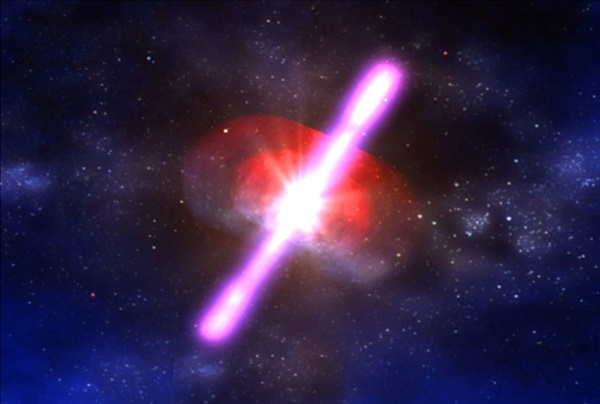Key Takeaways:
United Kingdom astronomers, using a telescope aboard the NASA Swift satellite, have captured information from the early stages of a gamma-ray burst – the most violent and luminous explosions occurring in the universe since the Big Bang.
Swift is able to both locate and point at gamma-ray bursts (GRBs) far quicker than any other telescope. By using its Ultra-Violet/Optical Telescope (UVOT) the astronomers were able to obtain an ultraviolet spectrum of a GRB just 251 seconds after its onset – the earliest ever captured. Further use of the instrument in this way will allow them to calculate the distance and brightness of GRBs within a few hundred seconds of their initial outburst and gather new information about the causes of bursts and the galaxies they originate from.
It is currently thought that immense explosions following the collapse of the core of a rapidly rotating, high-mass star into a black hole cause some GRBs, but many mysteries still surround these events.
“The UVOT’s wavelength range, coupled with the fact that Swift is a space observatory with a speedy response rate, unconstrained by time of day or weather, has allowed us to collect this early ultraviolet spectrum,” said Martin Still from the Mullard Space Science Laboratory (MSSL) at University College London (UCL).
“By looking at these earlier moments of gamma-ray bursts, we not only will be able to better calculate things such as the luminosity and distance of a burst, but also to find out more about the galaxies that play host to them and the impact these explosions have on their environments,” Paul Kuin said, also from MSSL, who works on the calibration of the UVOT instrument. “Once this new technique is applied to much brighter bursts, we’ll have a wealth of new data.”
Massimiliano De Pasquale, a GRB scientist of the UVOT team from MSSL, said, “The UVOT instrument is particularly suited to study bursts with an average to high redshift – a part of the ultraviolet spectrum that is difficult for even the very big ground-based telescopes to study. Using UVOT with Swift, we can now find redshifts for bursts that were difficult to capture in the past and find out more about their distant host galaxies, about ten billion light years away.”
Since its launch in 2004, the Swift satellite has provided the most comprehensive study so far of GRBs and their afterglows. Using the UVOT to obtain ultraviolet spectrums, the Swift team will be able to build on this study and even determine more about the host galaxies’ chemistry.
“The new spectrum has not only allowed us to determine the distance of the gamma-ray burst’s host galaxy, but also has revealed the density of its hydrogen clouds,” said Paul Kuin. “Learning more about these far-away galaxies helps us understand how they formed during the early universe. The gamma-ray burst observed on this occasion originated in a galaxy 8 billion light years from Earth.”










